-
- PCB TYPE
- PRINTED CIRCUIT BOARD PROTOTYPE ALUMINUM PRINTED CIRCUIT BOARD R&F PCB FPC HIGH FREQUENCY PCB HIGH-TG PCB HEAVY COPPER PCB HDI PCB PCB FOR LIGHTING METAL CORE PCB
time:Jul 02. 2025, 15:55:42
Introduction: The Evolution and Significance of Aluminum PCBs
In the ever-advancing landscape of electronic engineering, aluminum-based printed circuit boards (Al PCBs) have emerged as a transformative solution for applications demanding superior thermal management and mechanical resilience. Departing from traditional FR-4 substrates, Al PCBs harness aluminum’s unique physical properties to address critical challenges in heat dissipation, structural integrity, and electromagnetic compatibility. This article delves into the technical advantages, diverse applications, and engineering considerations of aluminum PCBs, illuminating their role in enabling innovation across automotive, aerospace, power electronics, and beyond.
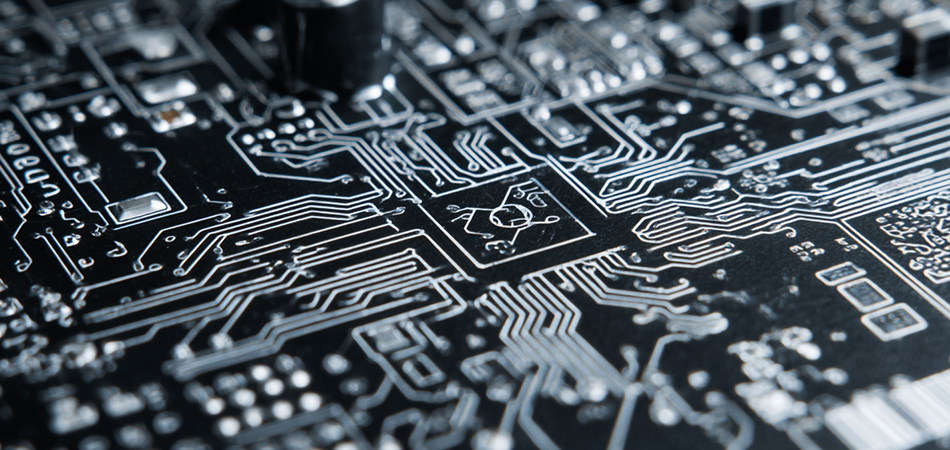
Material Advantages: The Core of Aluminum PCB Performance
Exceptional Thermal Conductivity for Efficient Heat Dissipation
Aluminum cores offer a thermal conductivity profile that far surpasses conventional fiberglass materials, providing an efficient pathway to dissipate heat generated by high-power electronic components. This property is particularly crucial in applications where thermal runaway could lead to component degradation or system failure, allowing Al PCBs to maintain operational stability across a wide range of temperature conditions. The aluminum core acts as an integrated thermal spreader, distributing heat uniformly to prevent hotspots and ensure consistent performance.
Mechanical Robustness and Electromagnetic Shielding
Mechanical Rigidity: Aluminum’s structural strength enables Al PCBs to withstand mechanical stresses such as vibration and shock, making them ideal for rugged environments in automotive and aerospace applications.
EMI Attenuation: The metallic nature of the aluminum core provides inherent electromagnetic interference (EMI) shielding, reducing signal degradation in high-frequency circuits and ensuring reliable operation in sensitive electronic systems.
Thermal Expansion Compatibility: With a coefficient of thermal expansion (CTE) closely matching that of many semiconductor devices, aluminum minimizes thermal stress on components, enhancing long-term reliability.
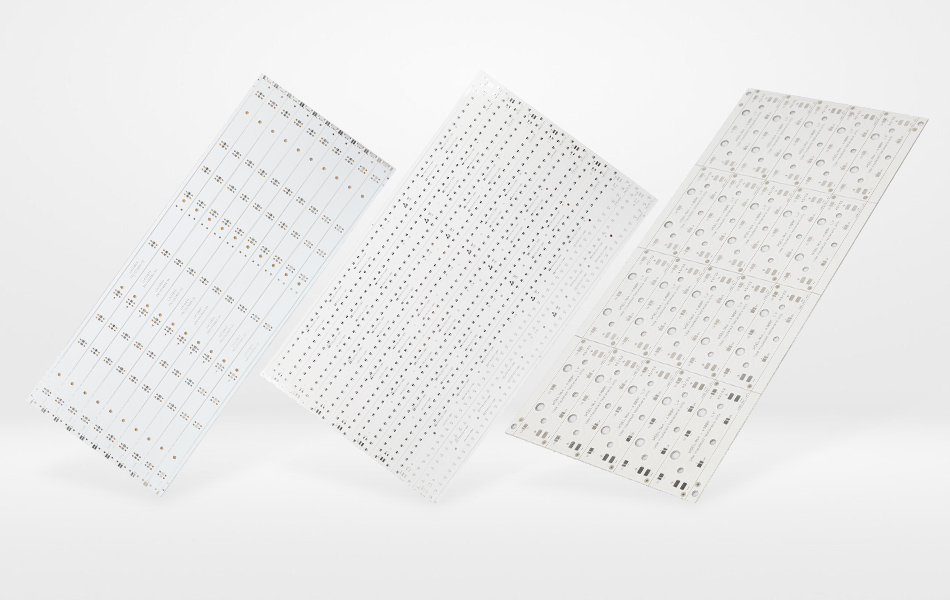
Diverse Applications: Where Aluminum PCBs Excel
LED Lighting: Balancing Brightness and Longevity
In LED lighting systems, Al PCBs play a pivotal role in:
Managing heat from high-intensity LED arrays to prevent lumen depreciation and extend operational life.
Enabling slim, lightweight designs for automotive lighting, commercial fixtures, and architectural applications through their thermal efficiency and mechanical flexibility.
Power Electronics: Enabling High-Density Power Conversion
For power management systems, Al PCBs facilitate:
Effective thermal dissipation in inverters, converters, and battery management systems, where switching losses generate significant heat.
Miniaturization of power modules by eliminating the need for external heat sinks, thus supporting higher power densities in renewable energy and industrial applications.
Automotive Electronics: Reliability Under Extreme Conditions
Key automotive applications include:
Engine control units (ECUs) and transmission modules, which require resistance to high temperatures and vibration in harsh under-the-hood environments.
Advanced driver assistance systems (ADAS) and autonomous driving sensors, where thermal stability is critical for consistent performance in varying climatic conditions.
Aerospace and Defense: Performance in Harsh Environments
Al PCBs are essential for:
Satellite communications and payload systems, demanding lightweight design with robust thermal management in the vacuum of space.
Military radar and avionics systems, which must operate reliably across extreme temperature ranges and withstand rigorous mechanical stresses.
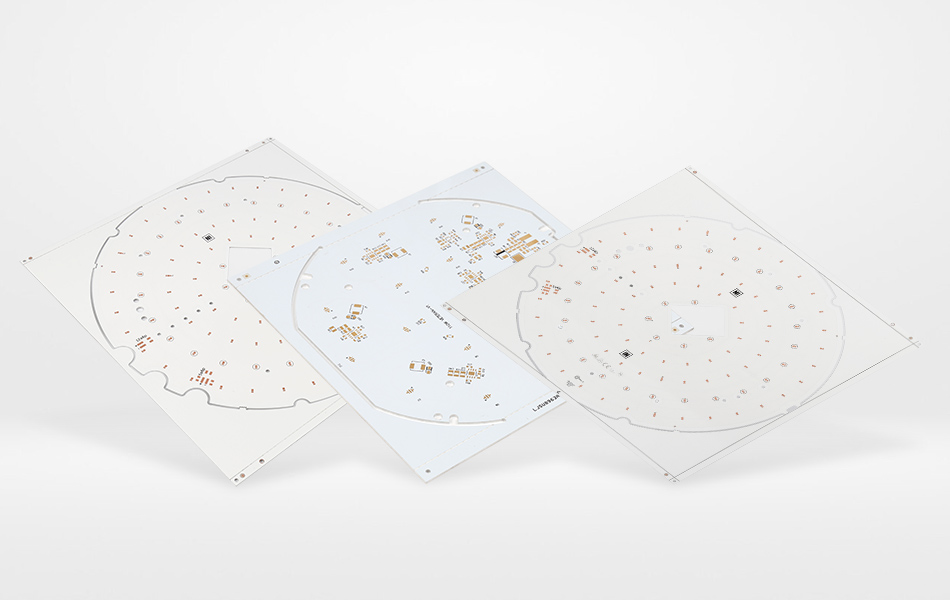
Design Considerations: Engineering Al PCBs for Optimal Performance
Layer Stackup and Material Selection
Dielectric Layer Optimization: Low-loss dielectric materials such as ceramic-filled polymers or polyimide films are chosen to balance electrical insulation with thermal conductivity, ensuring minimal signal loss and efficient heat transfer.
Core Thickness Strategy: Thicker aluminum cores (100–300 µm) are preferred for high-power applications requiring robust thermal dissipation, while thinner cores (50–100 µm) suit space-constrained designs in portable electronics.
Thermal Management Techniques
Integrated Heat Sink Design: The aluminum core can be machined into custom heat sink profiles, eliminating external cooling components and reducing system complexity.
Thermal Via Architecture: Strategically placed vias connect surface-mounted components to the aluminum core, creating direct thermal pathways that enhance heat dissipation efficiency.
Electrical Design Best Practices
Impedance Control: Precise layer stackup and dielectric material selection ensure consistent impedance in high-frequency signal traces, critical for maintaining signal integrity in RF and microwave applications.
Ground Plane Configuration: The aluminum core can serve as a continuous ground plane, minimizing EMI and improving noise immunity in complex circuit layouts.
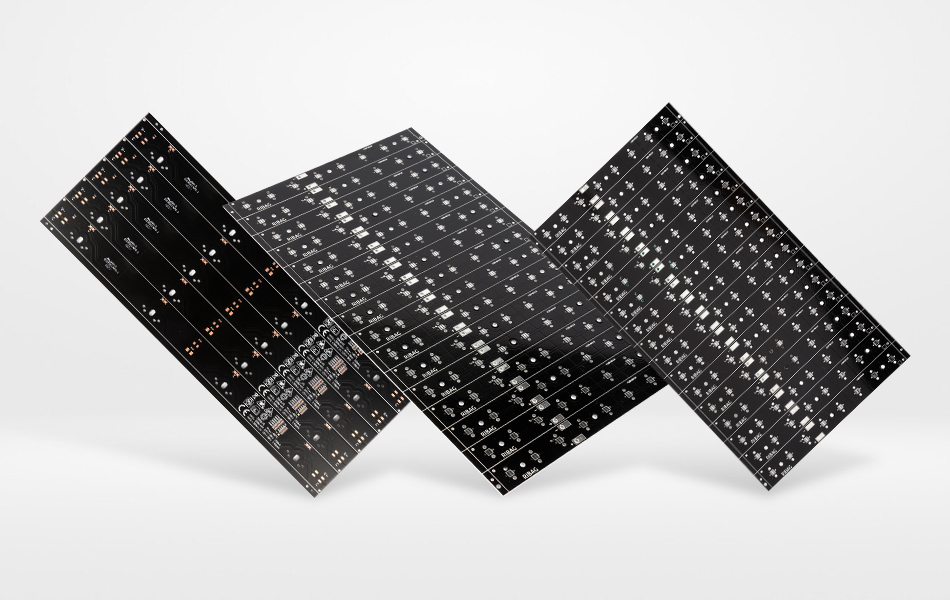
Manufacturing Processes: From Core to Completed PCB
Core Preparation and Surface Treatment
Surface Enhancement: Anodization or chemical roughening of the aluminum core improves adhesion to dielectric layers, preventing delamination during thermal cycling and ensuring long-term structural integrity.
Precision Machining: Computer numerical control (CNC) machining is used to shape the aluminum core, creating features such as heat sink fins or component cavities with high accuracy.
Lamination and Circuit Fabrication
Sequential Lamination: Dielectric layers are bonded to the aluminum core under controlled temperature and pressure, forming a homogeneous structure that balances thermal and electrical properties.
Copper Trace Formation: High-purity copper foils are laminated onto the dielectric surfaces and etched to create circuit traces, with thickened copper layers (2–4 oz) applied for high-current applications.
Via Formation and Electrical Connectivity
Drilling Technologies: Mechanical drilling or laser ablation is used to create vias, with laser drilling offering precision for microvias in high-density interconnect (HDI) designs.
Via Plating and Filling: Electroless and electrolytic plating processes ensure uniform copper deposition in vias, while thermal conductive fillers such as silver-loaded epoxies can be used to enhance thermal performance.
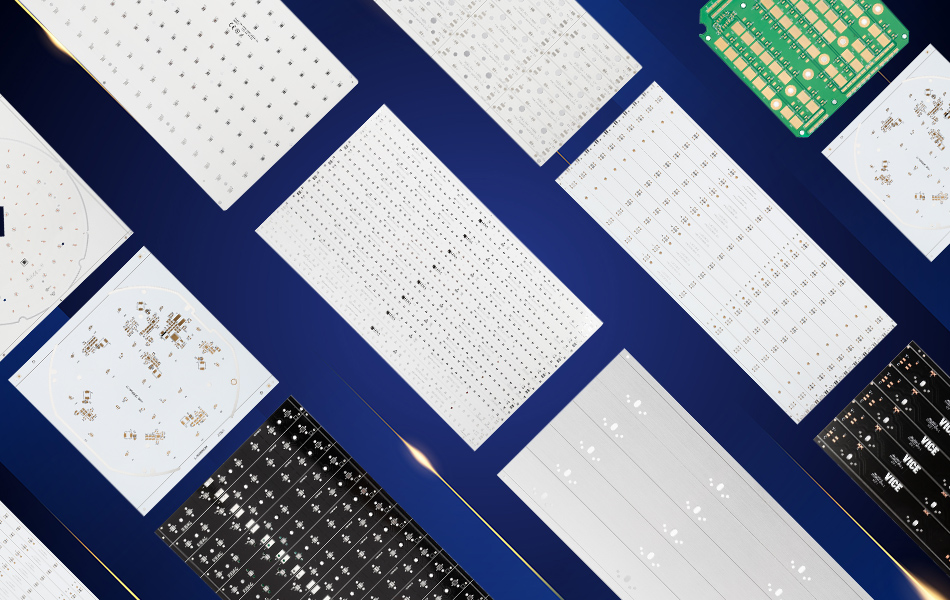
Testing and Quality Assurance: Ensuring Reliability
Thermal Performance Evaluation
Infrared Thermography: This technique maps temperature distributions on the PCB under operational load, identifying thermal hotspots and verifying the effectiveness of thermal management designs.
Thermal Cycling Tests: PCBs are subjected to repeated temperature cycles (-40°C to +125°C) to assess their resistance to thermal stress and ensure long-term reliability.
Electrical and Mechanical Validation
High-Voltage Dielectric Testing: This ensures that the dielectric layers maintain insulation integrity under operating voltages, meeting safety and regulatory standards.
Vibration and Shock Testing: Simulating real-world mechanical stresses, these tests verify that components remain securely attached and that the PCB structure remains intact.
Environmental Resistance Testing
Humidity and Corrosion Tests: PCBs are exposed to high-humidity environments or corrosive atmospheres to evaluate their suitability for outdoor or marine applications.
Emerging Trends in Aluminum PCB Technology
Advanced Material Combinations
Aluminum-Ceramic Composite Cores: These hybrid materials combine aluminum’s thermal conductivity with ceramic’s low CTE, enabling higher thermal performance and tighter design tolerances.
Graphene-Enhanced Dielectrics: Incorporating graphene into dielectric layers improves both electrical insulation and thermal conductivity, ideal for next-generation high-frequency applications.
Innovative Cooling Solutions
Micro-Channel Cooling Integration: Embedded fluid channels in the aluminum core enable liquid cooling for extremely high-power applications, such as data center power supplies or industrial lasers.
Phase Change Material (PCM) Integration: PCMs embedded in Al PCBs absorb and release heat during phase transitions, managing transient thermal loads in pulsed-power applications.
Digital Design Innovations
AI-Driven Thermal Simulation: Machine learning algorithms optimize via placement and layer stackup to minimize thermal gradients and improve overall thermal efficiency.
3D Printed Heat Sinks: Additive manufacturing techniques create complex, customized heat sink structures directly on the aluminum core, enhancing 散热 without increasing weight.
Conclusion: The Future of Aluminum PCBs in Electronics
Aluminum PCBs have redefined electronic design by addressing the concurrent demands of thermal management, mechanical reliability, and electrical performance. From illuminating urban landscapes with energy-efficient LED lighting to enabling next-generation automotive safety systems, their unique combination of properties makes them indispensable in modern electronics. As technology progresses toward higher power densities, smaller form factors, and more challenging operational environments, Al PCBs will continue to evolve—driven by advancements in materials science, manufacturing processes, and design methodologies. Their role in shaping the future of high-performance electronics, from 5G infrastructure to deep-space exploration, underscores their enduring significance in the electronics industry.

Got project ready to assembly? Contact us: info@apollopcb.com



We're not around but we still want to hear from you! Leave us a note:

Leave Message to APOLLOPCB
